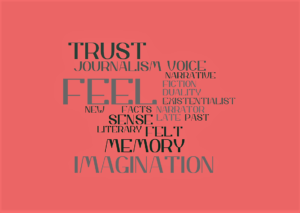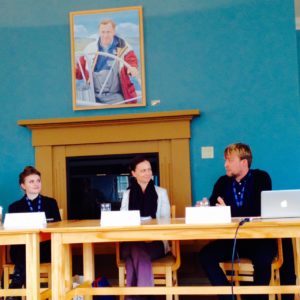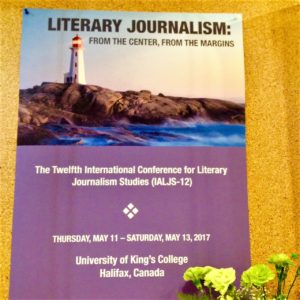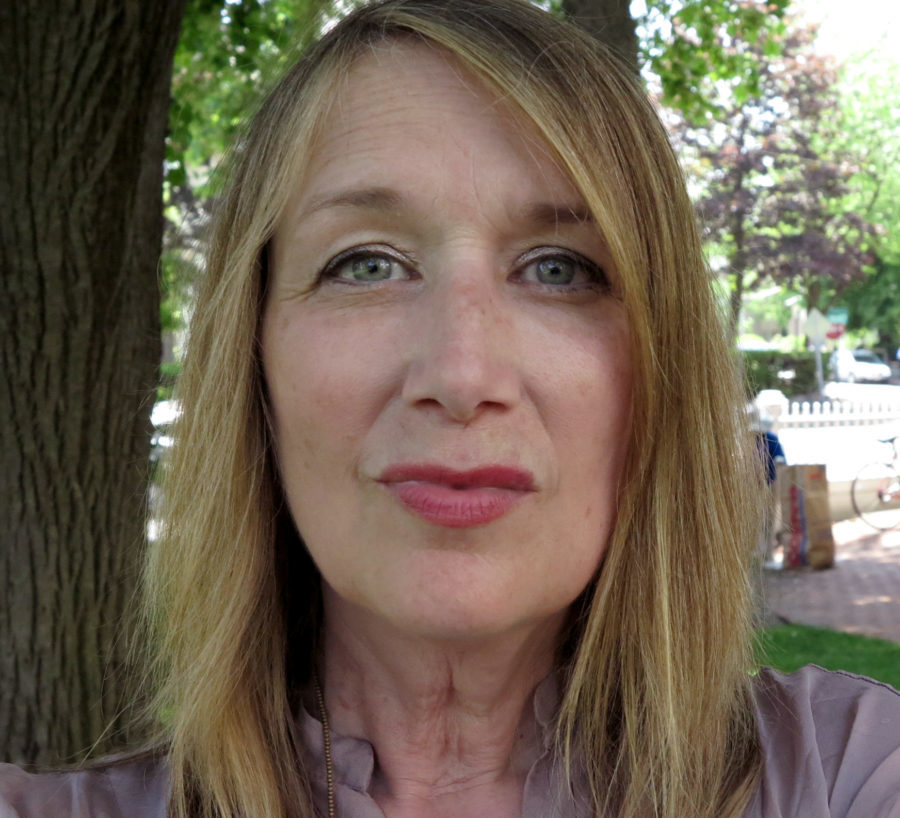
If you wanted to do a word cloud of the literary journalism conference I just attended in Nova Scotia, the word “feel” might be the largest image. Then imagination. And memory. And voice. And trust.
You’ll see above that I actually created something quite lovely with a word-cloud generator. Its pink glow fits the positive vibe of the conference, organized by the International Association for Literary Journalism Studies, which brought together scholars of the genre from Portugal, Mexico, Australia and just about everywhere in between.
“Facts aren’t enough. We need to feel them.”
At first, it was a bit disorienting to be a “practitioner” of journalism in a crowd of brainy academics. But then I realized that what unites is more important than what separates us: the love of literary journalism.
The thread running through the panels I attended, at least, was the sensory nature of this type of journalism, and how it connects readers to the subject through emotions while not forgetting the intellect.
That was the topic of one of the most intriguing talks, by Lindsay Morton of Avondale College of Higher Education in Australia. In this era of a president who regularly tweets about “fake news” in caps-lock mode, it might feel a bit edgy to argue for the championing of imagination in journalism. Morton disagrees.
Yes, she acknowledged, “the term ‘imagination’ is problematic because of its close association with invention.” But she argued: “All stories are a product of imagination. Reason and imagination need each other.”
After all, she said, “we are discoverers rather than recorders.”
Interestingly, two of the strongest advocates for the effective use of emotions in literary journalism were speakers who focused on science reporting.

One of the panel discussions at the conference.
Ryan Marnane, of Salve Regina University in Rhode Island, thinks we’re in need of more engagement in climate change journalism. And for him, that means merging the rational with the emotional.
“Facts aren’t enough,” he said. “We need to feel them.”
He focused on “Ballad of the sad climatologists,” a 2015 Esquire piece by John Richardson. In the story, Richardson opens with the controversy over one climatologist’s impulsive tweet: “If even a small fraction of Arctic sea floor carbon is released to the atmosphere, we’re f’d.”
Cue tweetstorm. The scientist had dared to go to the darkest side of climate change in a politically fraught time. But Richardson adds, “Worse, he showed emotion, a subject ringed with taboos in all science but especially in climate science.”
Marnane – who offered the great line “climatologists have become the new existentialists” – said that science writing can overflow you with information. What it needs instead, he argued, is “a rendering of felt detail.”
In another talk, Kate McQueen, who just earned her master’s degree at the University of Illinois Urbana-Champaign, talked about the power of empathy in science writing.
“The term ‘imagination’ is problematic because of its close association with invention.” But “all stories are a product of imagination. Reason and imagination need each other.”
Although she cited two great science-leaning literary journalists of the past and present – John McPhee and Jon Mooallem — she focused her talk on Peter Wohlleben’s surprise best-seller, “The Hidden Life of Trees.”
In it, he works to make the trees become more human.
“When you know that trees experience pain,” he writes, “and have memories and … live together with their children, then you can no longer just chop them down and disrupt their lives with large machines.”
McQueen argued that such an approach can win over readers who might not be inclined to worry about the fate of trees.
“An empathic view towards nature is not one we necessarily expect out of science writing, which — like the practice of science itself — is taken most seriously when grounded in empirical research and value-neutral language,” she said. “But journalists and writers at large who cover the natural world do much more than just repackage the latest news and research. They work hard to encourage a sometimes reluctant audience to take an interest in the world around them.”
 She made a point that ran through the conference: “More science writers are willing to address what scholars of literary journalism already acknowledge—that adherence to the purely objective is limiting.”
She made a point that ran through the conference: “More science writers are willing to address what scholars of literary journalism already acknowledge—that adherence to the purely objective is limiting.”
In the same session, two speakers turned the science-emotion idea on its head a bit by talking about the actual science that may be involved in reading literary journalism.
Isabel Nery, of the University of Lisbon in Portugal, talked about brain reactions to media and literature.
She said that it’s “easier to imagine the reader ‘falling in love’ with a piece of literary journalism than a traditional news story.” But what about the brain’s reaction to literary journalism? (I’m somehow picturing the old educational ad about “this is your brain on drugs.” For literary journalism, I’m picturing that egg being coddled instead of fried.)
She thinks it would be cool to observe MRI scans of people reading literary journalism and hard news to see how different the brain reaction is.
“That could help make future decisions on the business model of journalism,” she said.
Marie Vanoost, of the Catholic University of Louvain in Belgium, opened with a quote from reporter Amy Harmon: “I think that you absorb something more viscerally when your emotions are involved than when you’re just told.”
Vanoost decided to try to test that theory. She commissioned a study in which participants were given two versions of a health story, one written in narrative form and the other in the traditional inverted pyramid. Her hypothesis? That readers will remember information better in the narrative format.
In the initial study, at least, it turned out that women remembered the information better when reading it narratively. For men, the style of story didn’t affect their recall.
I don’t know why, but another initial finding surprised me: It was the men, not the women, who liked the narrative style over the inverted pyramid. Am I alone in that surprise? I’d love to hear from people on that.
On my last day in Halifax, I could hear the sound of a distant bagpipe serenading the city. It added a sensory layer to my experience there — and it deepened my feeling for it. Kind of like literary journalism does.


